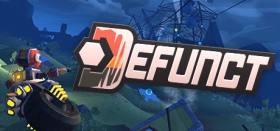
Defunct Review
The word ‘kinaesthesia’ refers to the way movement is felt through our bodies. ‘Kinetics’ is the study of motion, and the suffix “-thesia” denotes a relation to the senses. Thus, combining these two words, we get ‘kinaesthesia’. Much like the visual impact received by looking at a painting, or the tingling feeling when we listen to music, ‘kinaesthesia’ is hard to describe as it’s purely sensorial. The easiest way to understand it is by looking at how it feels to drive two different cars: how well they grip to the asphalt, the acceleration, etc. In videogames, this term has become increasingly important, as we develop ways to explore digital three-dimensional spaces. Defunct represents this idea at its core: an examination of pleasure through the sensation of motion. It is, perhaps, not the first one to do so, but one that does not seem too shy about making its purpose as overt as possible.
In Defunct, you control a cute, toy-like robot whose engine breaks down as soon as you start the game. On your way to get a repair, you soon accidentally fall from the massive spaceship you work in, which hovers over the planet and collects debris from crashes and decaying facilities, and onto the planet itself. In order to catch up to your flying home base, you have to ride across fields peppered with bulbous hills, dune-filled deserts and thrilling canyons, squeezing through the crevices in the rocks and racing other planet-dwelling robots along deserted and desolated roads. As the engine is barely functional, you have to make use of every single moment you’re travelling downhill, in order to gain momentum, and combine it with jumps and some loops, making sure that you never lose more speed climbing hills than what you gain on your way down.
 The protagonist of this austere story is a robot that for many, is reminding of WALL-E’s innocence and child-like approach to problems. The gestures are, admittedly, not as well-defined as in the film, but they carry that naïve expressivity that makes the robot, frankly, quite adorable. As you race across wastelands, dodging the rubble from other robots and spaceships that lie scattered inert, a bunch of white and graceful robots, a sort of improved version of you (EVA?), will join you and accompany your course. The trails of light they leave intertwine with each other and, alongside the whimsical and cheery soundtrack, and the thrill of the speed, you won’t be surprised to come back to these levels after you finished the game just to experience the pleasure of the smooth and harmonic motion achieved in this game.
The protagonist of this austere story is a robot that for many, is reminding of WALL-E’s innocence and child-like approach to problems. The gestures are, admittedly, not as well-defined as in the film, but they carry that naïve expressivity that makes the robot, frankly, quite adorable. As you race across wastelands, dodging the rubble from other robots and spaceships that lie scattered inert, a bunch of white and graceful robots, a sort of improved version of you (EVA?), will join you and accompany your course. The trails of light they leave intertwine with each other and, alongside the whimsical and cheery soundtrack, and the thrill of the speed, you won’t be surprised to come back to these levels after you finished the game just to experience the pleasure of the smooth and harmonic motion achieved in this game.
And for better or worse, that’s about it. This game’s simplicity in mechanics and story makes the few elements in there shine with more intensity, turning the game into a little orgasmic indulgence. However, not all levels accomplish this deliberate joyride. Some of them drop you in an enclosed area in which you have to activate several switches so as to open doors and activate currents. Whereas the means to do so are the same as in the rest of the levels, having to go back and forth to activate all these switches breaks the fluidity and the pace of the game. Some other parts force you to go really slow, but in general, these don’t present a big issue, as they make the better parts stand out and space out these moments. Defunct’s strongest points are hindered by the objective design and, particularly, by the unintelligible tutorial that seems to not give a damn about whether you get the gist of it or not.
 Defunct is, however, a solid game; the bare textures and simple shapes ease the player into understanding the paths available. The robot’s lights make that even clearer by informing about how to use the droid’s weight, particularly going downhill. The music, for such a short game, never feels repetitive or superfluous, but rather is used to tune the player into each setting. All in all, whereas Defunct lacks a completely beneficial objective design, even adding collectibles throughout the game, it is still a very tight and cohesive pleasant experience.
Defunct is, however, a solid game; the bare textures and simple shapes ease the player into understanding the paths available. The robot’s lights make that even clearer by informing about how to use the droid’s weight, particularly going downhill. The music, for such a short game, never feels repetitive or superfluous, but rather is used to tune the player into each setting. All in all, whereas Defunct lacks a completely beneficial objective design, even adding collectibles throughout the game, it is still a very tight and cohesive pleasant experience.
Defunct (Reviewed on Windows)
This game is good, with a few negatives.
Defunct's way of conveying the sense of motion and fluidity works great with the control and management of the robot's position. However, its simplicity and strange objective design can present some drawbacks.










COMMENTS